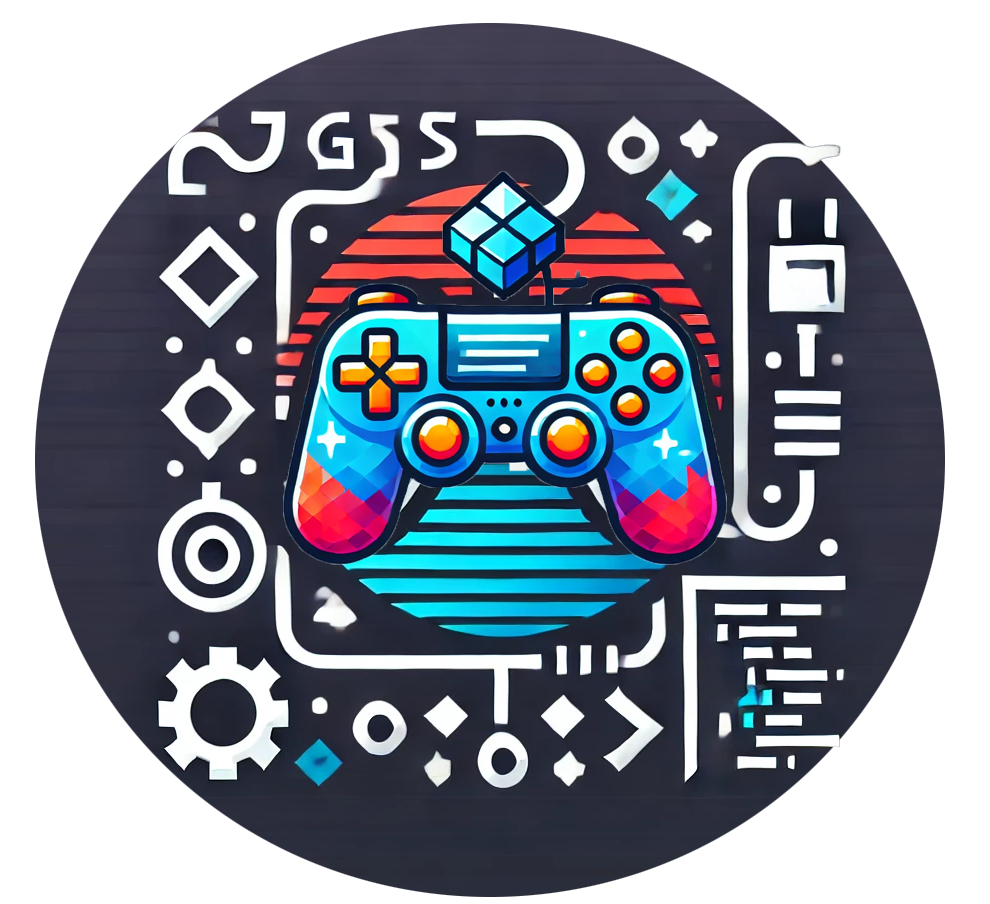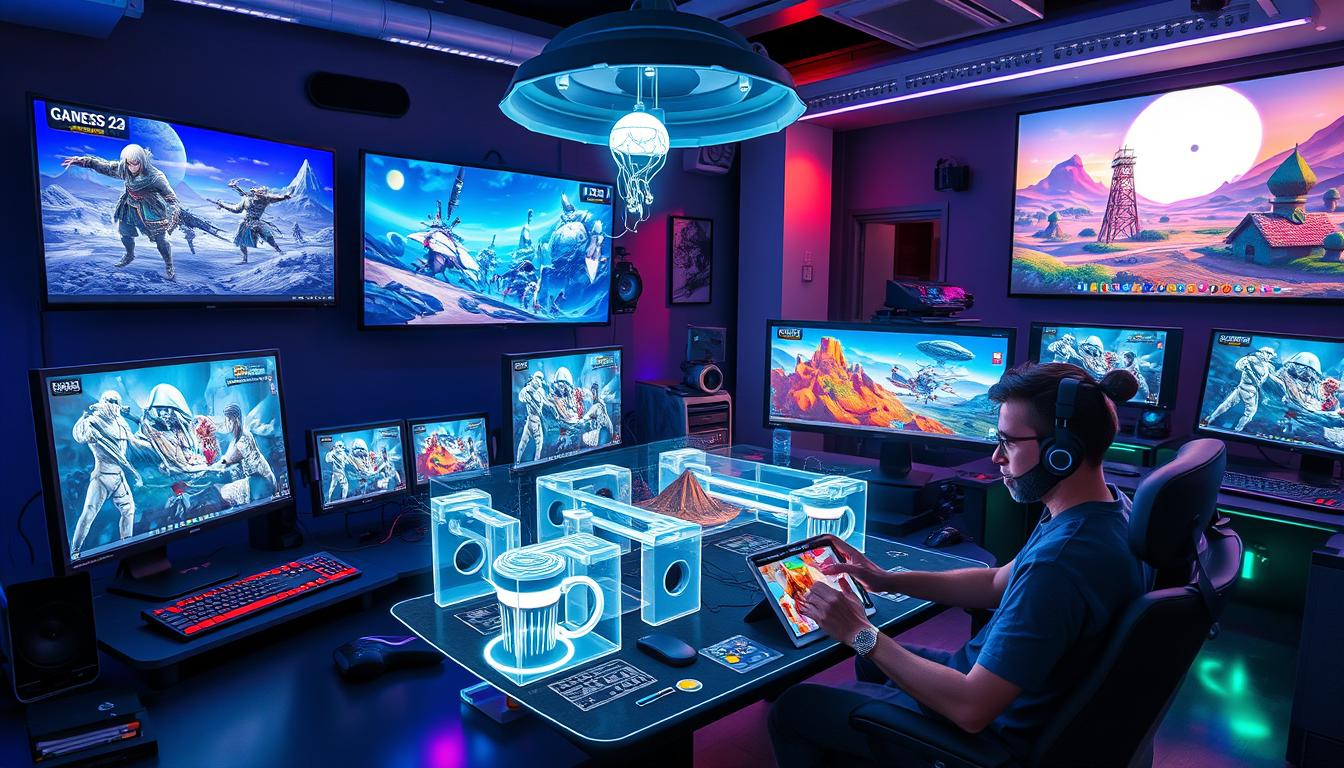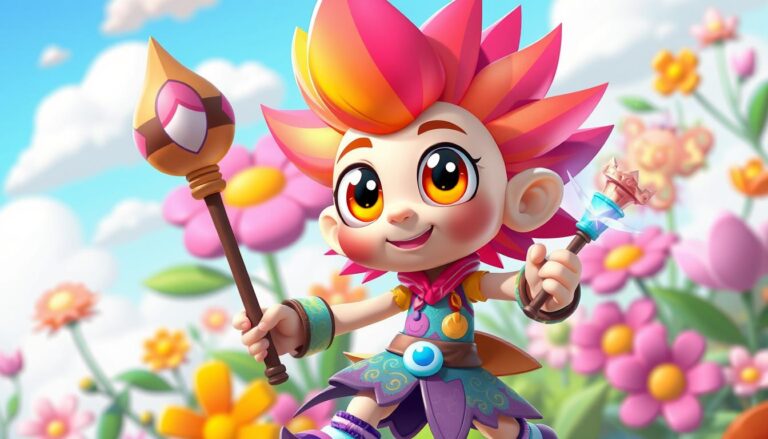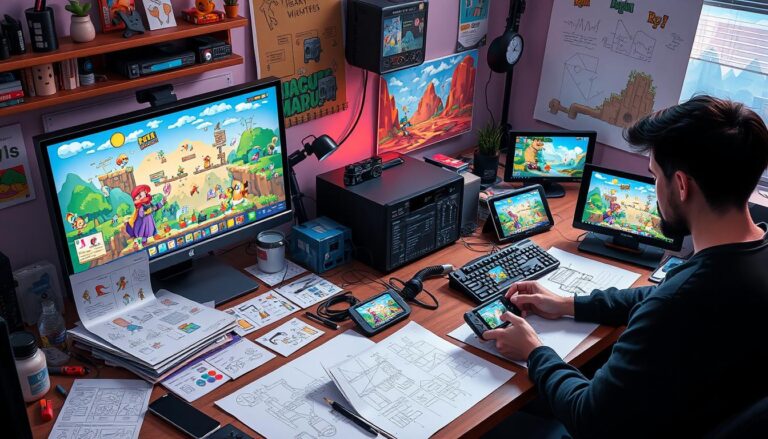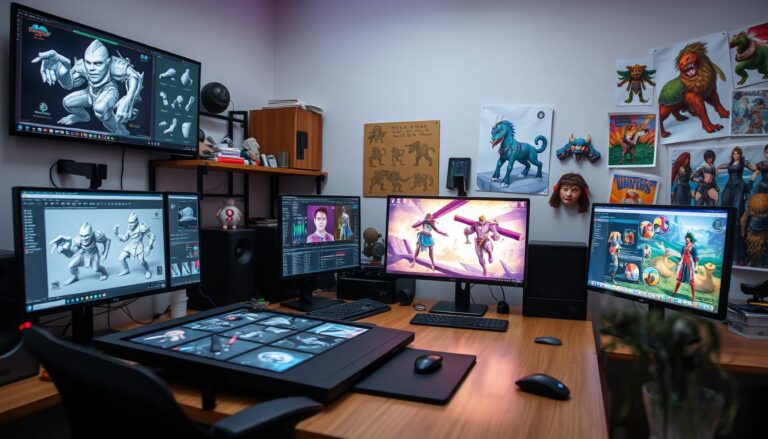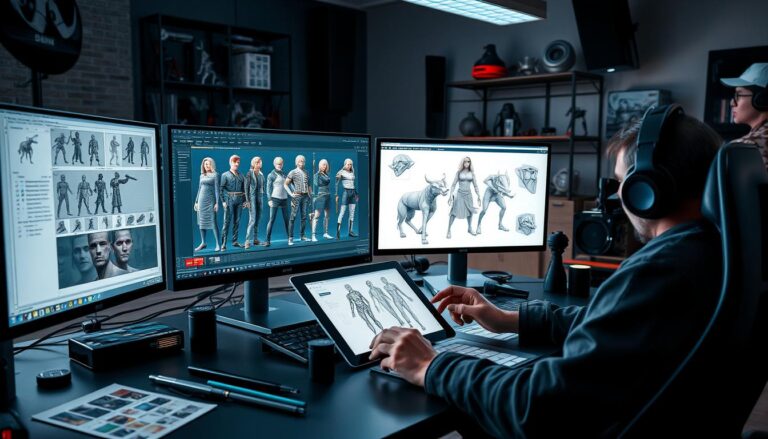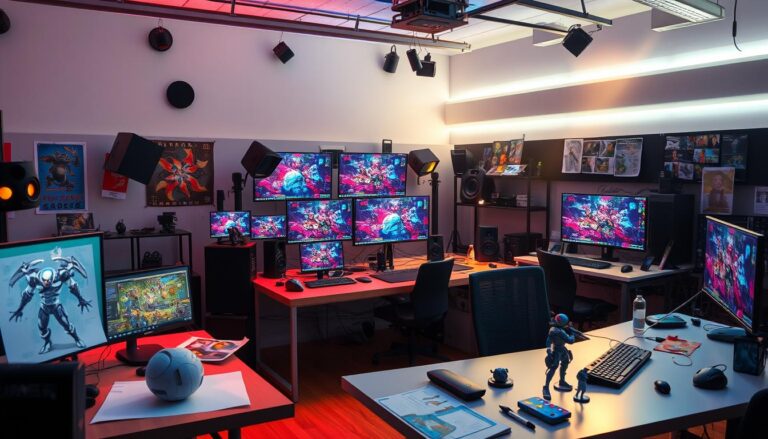What Are the Best Engines for 3D Game Development?
The global gaming market is set to hit $503.14 billion by 2025. This shows the huge potential in the gaming world. Game engines are key, offering tools for making games, graphics, and more. They handle important tasks like physics and visuals, letting developers focus on the game itself.
Popular game engines include Unreal Engine, Unity, CryENGINE, and GameMaker. Each has its own strengths and features for 3D game making. Knowing what each engine can do is vital for creating amazing 3D games.
We’ll look into game engines’ basics, top commercial options, and free alternatives. This will help developers pick the right engine for their projects. By understanding each engine’s strengths and weaknesses, developers can make the best choice for their games.
Understanding Game Engine Fundamentals
Game engines are key to making modern games. They offer a complete setup for creating 3D games that look and feel amazing. These tools help developers turn their ideas into reality.
Core Components of Game Engines
Game engines have several important parts. The rendering engine handles visuals, the physics engine makes things look real, and the scripting system controls game actions.
Key Features for Game Development
Game engines have many features to make game making easier. Tools like Blueprints in Unreal Engine or Shader Graph in Unity let non-coders create game parts. They also have great asset management systems and cross-platform compatibility.
Role of Game Engines in Modern Development
Today, game engines are vital for making games fast and engaging. They help with artificial intelligence, animation, physics simulations, and audio. This lets developers focus on making games fun and beautiful.
| Game Engine Feature | Description |
|---|---|
| Game Architecture | Comprehensive frameworks for managing game logic, events, and asset integration. |
| Scripting | Powerful scripting languages and visual programming tools for customizing game behaviors. |
| Game Physics | Robust physics engines for realistic simulations of rigid bodies, soft bodies, and fluids. |
| Level Design | Intuitive tools for crafting game environments, managing scenes, and organizing assets. |
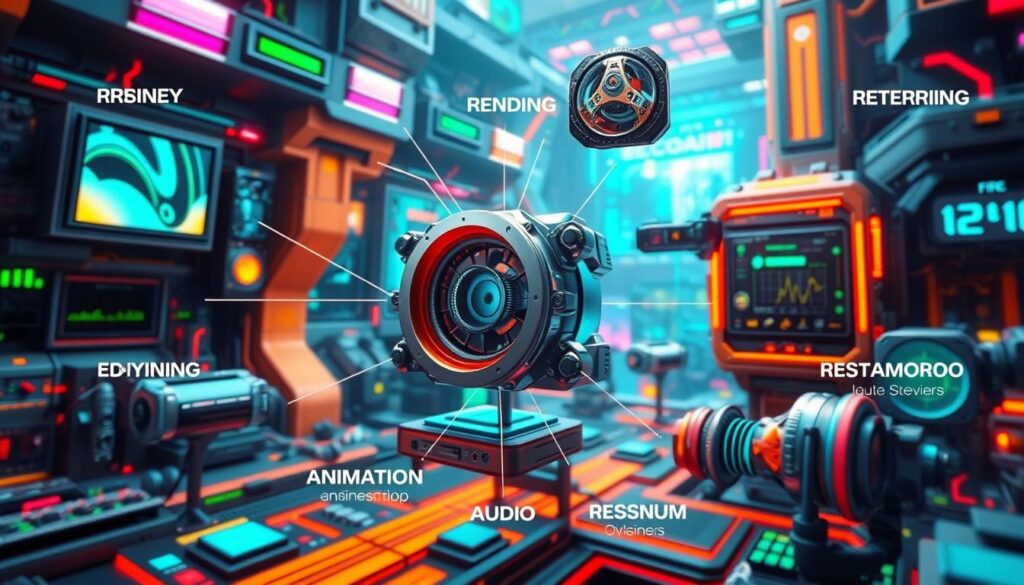
Top Commercial Game Engines for Professional Development
The game development world is booming. The global gaming market is expected to hit $503.14 billion by 2025. This is up from $396 billion in 2023. Several top commercial game engines lead the way for professional developers and big studios.
Unreal Engine, owned by Epic Games, has been a leader since 1998. It’s known for its scalability and customization. Unreal Engine 5, launched in 2022, is quickly becoming popular on next-gen consoles like PlayStation 5 and Xbox Series X.
Unity is famous for 2D and 3D development. It supports mobile games well and has advanced VR/AR features. Over half of all games use Unity, known for creating interactive 3D content on various platforms.
CryENGINE, made by Crytek, offers amazing visuals and VR support. It’s free to use and has full engine source code. This makes CryENGINE a great choice for professional developers wanting a customizable engine.
Lumberyard, backed by Amazon Web Services (AWS), is great for online play and VR. It’s perfect for developers aiming to make games with strong online features and VR support.
These commercial game engines meet the needs of professional developers. They provide powerful tools, cutting-edge tech, and the ability to make high-quality 3D games on many platforms. Each engine has its own strengths, giving developers many options for their next project.
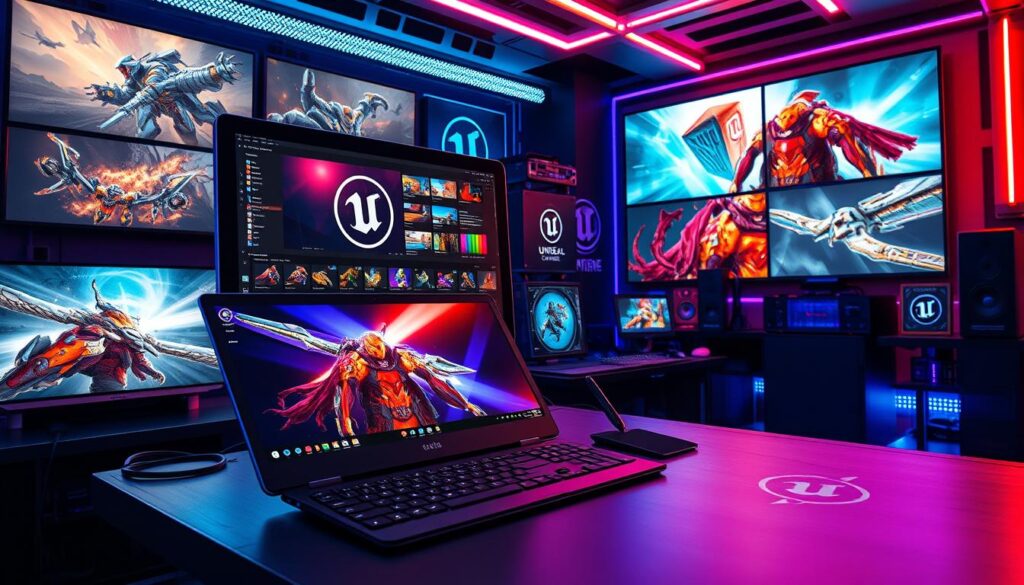
| Engine | Key Features | Platforms |
|---|---|---|
| Unreal Engine | Scalability, customization, visual fidelity | Windows, Mac, mobile, consoles, VR |
| Unity | 2D/3D development, mobile support, VR/AR | Windows, Mac, mobile, consoles, VR |
| CryENGINE | Stunning visuals, VR support, free-to-use | Windows, Mac, mobile, consoles, VR |
| Lumberyard | Online play integration, VR preview, AWS integration | Windows, Mac, mobile, consoles, VR |
3D Game Development: Leading Platforms and Solutions
In the world of 3D game development, top platforms and solutions offer advanced tools. They help create amazing visual experiences. These engines are great at graphics, physics, animation, and more, letting developers turn their ideas into reality.
Graphics and Visual Capabilities
Game engines like Unreal Engine and Unity have changed the game. They bring stunning visuals to 3D games with real-time lighting and physics. Unreal Engine’s Nanite and Lumen are setting new standards in graphics.
Unity’s Asset Store has a huge collection of resources. It helps with modeling, texturing, and making games look great.
Physics and Animation Systems
Good physics and animation systems make games feel real and fun. Top engines have advanced physics for accurate game play. They also have tools for smooth animation of characters and scenes.
Development Tools and Asset Management
Modern game engines focus on making development easier. They have visual scripting, IDEs, and asset management tools. These help developers work efficiently, from modeling to animating assets.
Using these top platforms, 3D game developers can make amazing games. They get to use advanced graphics, physics, and tools. This helps create games that are both beautiful and engaging.
Open-Source and Free Game Engine Options
The game development world is changing fast. Now, open-source and free game engines are great for indie developers and small studios. They are affordable and come with big communities, lots of documentation, and the chance to change the code as needed.
Godot is a top open-source engine. It’s free and supports both 2D and 3D games. Its unique design and customization options make it a favorite among indie game makers. Panda3D is great for simulations and visualizations, with advanced graphics and physics. Spring Engine is perfect for real-time strategy games, with a modular design and support for Lua scripting.
| Engine | Godot | Panda3D | Spring Engine |
|---|---|---|---|
| Type | 2D and 3D | 3D | Real-Time Strategy |
| Licensing | Free and Open-Source | Free and Open-Source | Free and Open-Source |
| Supported Languages | C#, C++, Godot Script | C++, Python | C++, Lua |
| Key Features | Node-based architecture, extensive customization | Advanced graphics, physics simulation | Modular architecture, Lua scripting support |
These open-source game engines are full of chances for developers looking for affordable and flexible options. With their strong communities, detailed guides, and code modification possibilities, Godot, Panda3D, and Spring Engine are great alternatives to pricey game engines. They help creators turn their unique ideas into reality.
Comparing Engine Performance and Capabilities
Choosing a game engine is key to your project’s success. Each engine has its own strengths and meets different needs. It’s important to know their technical needs and support for various platforms.
Technical Requirements and System Specifications
Unreal Engine and CryENGINE offer top-notch graphics but need powerful hardware. On the other hand, Unity and Godot work well on many systems. This makes them great for developers with different hardware setups.
Platform Support and Cross-compatibility
Being able to run on many platforms is vital. Unity supports over 25 platforms, including Windows, macOS, and mobile devices. Unreal Engine also makes it easy to port games to various systems.
Learning Curves and Development Speed
The ease of use affects how fast you can develop your game. Unreal has visual scripting that’s easy for non-coders. Unity is also user-friendly, helping both new and experienced developers.
Choosing the right engine depends on your project’s needs, platforms, team skills, and desired quality. Knowing each engine’s strengths helps you pick the best for your Game Architecture, Optimization, and Cross-platform Development goals.
Conclusion
Choosing the right engine for 3D game development is key. It depends on what your project needs, your team’s skills, and where you want to release your game. Engines like Unreal and Unity are top choices for pros. They have lots of features to make amazing 3D games.
For indie developers, open-source options like Godot are great. They’re flexible and save money. This makes them perfect for smaller projects.
When picking a game engine, think about graphics, physics, and how well it works on different platforms. Also, consider how easy it is for your team to learn. As VR and AR grow, game engines are more important than ever.
Whether you’re an experienced developer or just starting, knowing what each engine can do is crucial. It helps you pick the best one for your project. This way, you can create games that are both fun and engaging for players everywhere.
